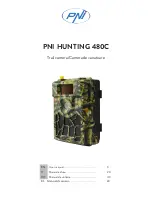
27
lead to errors. If your network is set up for DHCP, this is generally the best configuration to choose.
If you do choose to go with a Static IP address, you’ll need to add the IP Address, Subnet Mask and Gateway
Address information according to the requirements of your network.
DHCP Timeout, Fallback IP address, Fallback Subnet Mask
You can set the timeout period during which P120 will look for a DHCP IP address. After this period, the camera will
default to the designated fallback IP address.
This can be useful if you use your camera in other network environments. For example, if a DHCP server is available
in your normal office or studio application, the camera will use the DHCP supplied IP address. If you then use the
camera in another application without a DHCP server, your camera will always default to the known fallback IP
address. NOTE: Do not set the fallback IP address the same as the camera IP address. It is recommended to keep
the fallback IP address.
BirdDog Name
You can give your camera a meaningful name to make identification easier when viewing NDI® sources on a
receiver such as a TriCaster, vMix or Studio Monitor. Be sure to make the name unique, as no two devices on the
network should have the same name. The name can be any combination of a-z, 0-9, and '–‘.
After renaming your camera, navigate back to the System menu and click the REBOOT button. The camera will
re-initialize and you’ll be good to go.
NDI Network Settings
P120 operates with the latest NDI® Libraries. There are several options to configure P120 behavior in an NDI®
network. Each configuration has its benefits, however it is recommended to utilize the default TCP transmit method
unless you have reason to change.
Preferred Transmit Method
TCP
TCP is the default method of transmission for NDI®. It operates well within local networks with predictable latency
and limited jitter. BirdDog recommends that TCP be used for typical applications, and only using alternative
transports for specific reasons.
UDP
UDP is recommended for networks where there is extended latency from one end to the other. The nature of
UDP means that it does not receive a confirmation of each packet being successfully received – vastly improving
performance on busy networks. UDP can have some consequences if there are other issues on the network such
as jitter or lost packets as it will not inherently re-sent a lost packet.
Содержание P120
Страница 1: ...FULL NDI PTZ CAMERAS LEVELLED UP USER GUIDE NDI 5 2022 ...
Страница 56: ...52 Camera Dimensions Unit mm 145 171 152 95 97 ...
Страница 59: ...WELCOME TO THE FUTURE ...
Страница 60: ...birddog tv hello birddog tv ...
















































